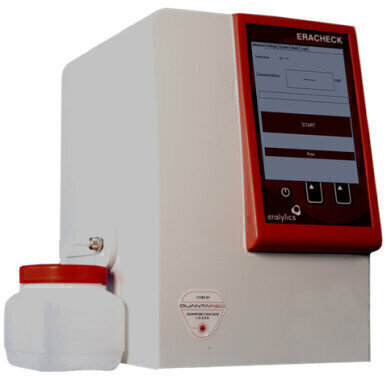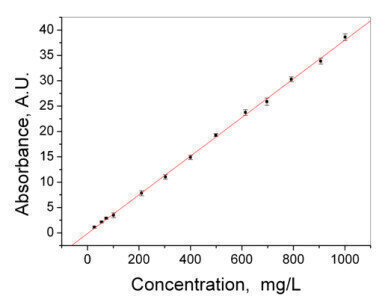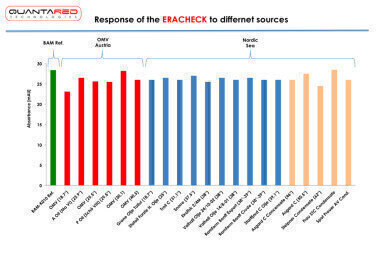-

-
 Fig 1
Fig 1 -
 Fig 2
Fig 2
Analytical Instrumentation
QuantaRed laser technology revolutionizes oil in water measurement
Dec 16 2009
CFC-free measurements on site: the ERACHECK goes below 1 ppm
The advent of Quantum Cascade Lasers (QCLs) as a new, powerful mid-IR light source has opened the possibility to develop a fast and ecologically friendly method for quantifying oil in production water and wastewater. After extracting the hydrocarbons with cyclohexane or cyclopentane instead of ozone depleting freon, precise concentrations can be determined by means of mid-IR laser spectroscopy.
The ERACHECK oil in water analyzer was developed by QuantaRed Technologies GmbH, Austria (www.quantared.com), in cooperation with EralyticsTM GmbH, Austria (www.eralytics.com). The benchtop instrument is easy to use (touch screen operation) and allows CFC free measurements with high precision and sensitivity (sub-ppm concentrations). Due to its portability and a measurement time of only 2 minutes the ERACHECK may be used on-site as well as in mobile or stationary laboratories.
The obstacles of standard methods
In the petrochemical industry there is a need for a portable analyzer capable of rapid and accurate analysis of hydrocarbons in water in the low ppm range. Information on the hydrocarbon content is needed for process control as well as to comply with regulatory issues. Former well established methods for this parameter (DIN 38409-H18, ASTM 3921) were based on mid-IR spectroscopy. These methods required a liquid-liquid extraction step using fully halogenated solvents, in most cases 1,1,2 trichloro-1,2,2 trifluoro-ethane (CFC) prior to analysis by mid-IR spectroscopy. This method was well accepted in routine laboratories due to its simplicity and ease of use. However, due to environmental concerns, especially with regard to the ozone depleting effect of CFCs, alternative methods have been developed in recent years. In this context ISO 9377-2 needs to be mentioned as it is the new European standard method for measuring hydrocarbons in water. As DIN 38409-H18, ISO 9377-2 is based on a liquid-liquid extraction step which ensures complete recovery of the hydrocarbons from water as well as from the surfaces of sample containers. Extraction solvent hydrocarbons with a low boiling point, such as hexane or cyclopentane should be used. In contrast to DIN 38409-H18, ISO 9377-2 uses gas chromatography for quantifying the extracted hydrocarbons. This chromatographic step allows separation of the analytes from the extraction solvent and thus enables quantification of hydrocarbons present in the extraction solvent. Quantitative results are obtained from integration of the chromatogram between the retention times of decane (C10) and tetracontane (C40). Due to the nature of this analysis procedure a fully equipped laboratory is required to carry out ISO 9377-2. Therefore ISO 9377-2 cannot easily be implemented in portable analyzers.
QCLs make the difference
Quantum Cascade Lasers (QCLs) are new, powerful mid-IR light sources which enable combining the advantages of DIN 38409-H18 with those of ISO 9377-2. The new method for determining hydrocarbons in water was developed by QuantaRed Technologies GmbH in close cooperation with the Vienna University of Technology and with Eralytics GmbH. It is based on extracting the sample with a cyclic hydrocarbon, preferably cyclohexane or cyclopentane and measurement of the extracted hydrocarbons in the cyclic extraction solvent by mid-IR laser spectroscopy. This is made possible by the fact that non-cyclic hydrocarbons show IR absorptions slightly different from those of cyclic aliphatic hydrocarbons. Using QCLs it becomes possible to exploit these small differences for accurate determination of hydrocarbons in the low ppm and even sub-ppm range.
With state of the art FTIR instrumentations it is not possible to measure hydrocarbons extracted into cyclohexane or cyclopentane at the desired concentration levels. However, when the FTIR instrument is replaced with a QCL, reliable measurements become possible, even at path lengths of several millimetres. This is due to the spectral power densities of QCLs, which are several orders of magnitude higher than those of thermal light sources employed in FTIR spectrometers.
Never change a winning team
Whereas novel quantum cascade laser technology has practical benefits in terms of measurement quality and environmental issues, the procedure for extracting the hydrocarbons from water stays unchanged. When using cyclohexane or cyclopentane as the extraction solvent, complete recovery of the hydrocarbons in an aqueous sample can be achieved. Similar to DIN 38409 H18 and ISO 9377-2 the obtained extract can be dried with Na2SO4 and filtered over solid phase materials like Florisil® to remove polar components.
ERACHECK – calibration and operation
The ERACHECK can be calibrated using standards containing the target hydrocarbon source or hexadecane standards, respectively, both dissolved in cyclohexane or cyclopentane. Different calibrations can be stored on the instrument and selected whenever necessary. Prior to sample measurement a background measurement needs to be performed which is stored on the instrument. Measurement of background and sample is accomplished within two minutes. Push button simplicity using the touch screen display also allows non-specialist personal to perform reliable measurements. Experimental data and results are stored on the instrument’s PC and can be accessed via USB, Ethernet and RS 232 interfaces.
The linear range of the ERACHECK extends from 0.5 to 1000 ppm. A characteristic calibration curve established with hexadecane dissolved in cyclohexane is shown in Fig. 1.
One Calibration fits all
The capability of the ERACHECK to analyze samples from different sites in Austria and the North Sea, including crude oil and condensate samples, using one calibration, was assessed. For this purpose a constant amount (500 ppm) of these samples was dissolved in cyclohexane and measured with the ERACHECK. The results obtained were uniform as depicted in Fig. 2. It is of special interest to see that no significant difference in the response of the ERACHECK between crude oil and condensate samples was observed. Therefore it may be concluded that using the ERACHECK it would be possible to analyze all studied samples using the same calibration. The BAM (“Bundesanstalt für Materialforschung und -prüfung”) reference standard can be used as a reproducible hydrocarbon composition.
CONCLUSION
Based on mid-IR quantum cascade laser technology the ERACHECK is capable to perform fast and reliable measurement of hydrocarbons in water from 0.5 to 1000 ppm. The ERACHECK method is CFC free and guarantees high precision and sensitivity. Due to its portability the ERACHECK provides reliable results on-site which save time and transportation costs.
Digital Edition
PIN 25.1 Feb/March
March 2024
In This Edition Safety - The technology behind the ION Science Tiger XT - Safety with ammonia and LOHCs as hydrogen carriers Analytical Instrumentation - Discussion on new tribology te...
View all digital editions
Events
Apr 28 2024 Montreal, Quebec, Canada
Apr 30 2024 Birmingham, UK
May 03 2024 Seoul, South Korea
May 05 2024 Seville, Spain
May 06 2024 Riyadh, Saudi Arabia

















